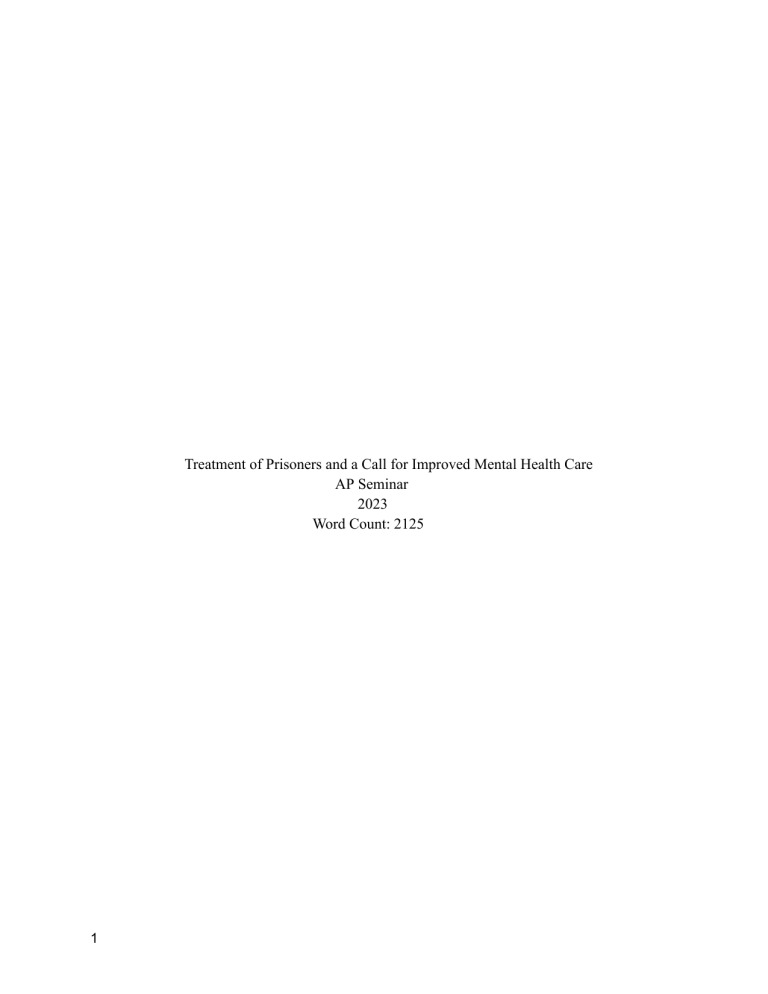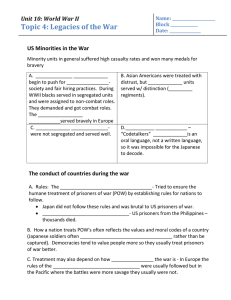Treatment of Prisoners and a Call for Improved Mental Health Care
advertisement

Treatment of Prisoners and a Call for Improved Mental Health Care AP Seminar 2023 Word Count: 2125 1 Treatment of Prisoners and a Call for Improved Mental Health Care The American Prison System has gone through a vast change in the lifespan of the country. By the late twentieth century, the U.S prison population was under 200,000. In less than half a century, that number would increase over seven-fold (Golembeski, 2008). Catalysts for such a monumental increase would include revisions in sentencing regulations and a more strict approach to reducing crime rates. Rather than providing much required help to prisoners and converting them to ideal samaritans, these revisions in law have instead perpetuated gruesome living conditions in American prisons. The autobiography “Long Walk to Freedom'', written by former South African president Nelson Mandela, discusses in great detail the physical and psychological turmoil he - alongside countless other prisoners - was forced to endure during his nearly three decade sentence in South African prisons. Despite the text referring to prisons in a completely different region, it still remains a valuable source for comparison to prison conditions in the U.S while simultaneously introducing the importance of mental fortitude amongst prisoners. The same year that Nelson Mandela was released, the United Nations adopted and proclaimed the Basic Principles for the Treatment of Prisoners, which establishes the mandatory maintenance of basic human rights of prisoners in prisons worldwide. Despite this, U.S prisons completely disregard these principles, instead borderline torturing its inmates with overcrowding, unnecessary violence, and containing them in disease-ridden conditions. When analyzing this issue through a psychological and social lens, the frightening rates of recidivism, detriments of solitary confinement, and the government’s tendency to sweep it under the rug all become evident in their correlation to the decline of prisoners' mental health. This, in turn, begs the question at hand: To what extent do the treatment of prisoners in American prisons call for higher quality mental health care? The treatment of prisoners warrants immediate mental health 2 AP Seminar Treatment of Prisoners and a Call for Improved Mental Health Care innovations through prison-based programs alongside an increase in legal regulations in prison operations. The United States has the largest prison population in the world. The Federal Bureau of Prisons reports the population held in federal prisons to be circa 1.2 million in 2021 (2022), around 3 out of every 1000 people in the country. With such an astronomical percentage of the population in prisons, concerns regarding the treatment of prisoners have been on the uprise. The most salient of these concerns are on overcrowding, solitary confinement, and the lack of government involvement in genuinely assuring criminal correction. The severity of these issues are further coupled with the fact that mental illnesses in prisoners have far higher rates than that of the general population (Gonzalez & Connell, 2014). Despite all this, the government fails to provide mentally handicapped prisoners with proper treatment. Reasons behind this seem to be limited resources (Gonzalez & Connell, 2014) and cuts in correctional funding (Scott-Hayward, 2009). Nonetheless, the detriments of this lack in treatment proves itself through disproportionate rates of recidivism (Treatment Advocacy Center, 2009). As prisoners victim to mental illnesses are subject to harsh living conditions in prisons, the need for action exponentially increases. When analyzing this problem through a psychological lens, one of the most prevalent factors in prisoner injustice lies in solitary confinement. The practice of solitary confinement in the United States dates back to the late eighteenth century, with it first being implemented in Pennsylvania in 1787 (Reiter, 2012). By the end of the first half of the nineteenth century, prisons across the country began implementing solitary confinement as punishment (Reiter, 2012). However, the system was quickly condemned by many, with European visitors such as Tocqueville and Beaumont describing it as a system that “devours the victim incessantly and unmercifully; it does not reform, it kills”. (Beaumont & Tocqueville as cited in Reiter 2012). 3 AP Seminar Treatment of Prisoners and a Call for Improved Mental Health Care What makes solitary confinement so crippling is the extensive isolation prisoners are subjected to. More so, the lack of social interaction that follows being in solitary confinement. According to Sheldon Cohen, Professor of Psychology at Carnegie Mellon University, social interaction with others aids in emotional regulations as well as limits the severity and span of negative mental health affects (Cohen, 2004). When people begin to succumb to excess stress, it activates coping responses such as substance abuse and sleep loss. Repeated activation of such responses may lead to a myriad of psychiatric disorders (Cohen, 2004). However, social interactions decrease the activation of such responses. This is because as people under stress begin to interact with others, the belief that others will provide support and necessary resources is reinforced. As a result, Cohen continues, the ability to cope with stress in a healthy manner is strengthened and negative psychological and emotional effects are severely diminished (Cohen, 2004). The significance of social interaction is further stressed in a report published by Debra Umberson, professor of sociology at the University of Texas at Austin, and Jennifer Karas Montez, Ph.D holder and professor of psychology at Syracuse University. According to the report, it's stated that as greater social connections are made, one’s sense of purpose and meaning in life increases (Umberson & Montez, 2010). This can directly enhance mental health and psychological well-being, which in turn may decrease involvement in unhealthy physical habits (Umberson & Montez, 2010), consistent with Cohen’s findings. These findings all reinforce the significance of social interaction in an individual’s life. Thus, by stating the positive effects of social interaction, these reports also naturally imply that there is severe harm in the lack of such interaction. According to the Treatment Advocacy Center, prisoners in solitary confinement are typically held in cells for 23 hours a day, with severely limited human interaction (2009). Furthermore, with the number of severely mentally ill prisoners multiplying in recent years, a 4 AP Seminar Treatment of Prisoners and a Call for Improved Mental Health Care large percentage of these prisoners find themselves locked up in solitary confinement (2009). With these two problems stacked up on one another, implications from the findings of Cohen, Umberson, and Montez become clear: the conditions of mentally ill prisoners in solitary confinement become severely worse as a result of being deprived of human interaction. The importance of social interaction, especially in a prison environment, is implied greatly in Nelson Mandela’s autobiography “Long Walk To Freedom”. In the latter half of the book, Mandela discusses the prison lifestyle and how it’s created with the intent of mentally breaking prisoners. Prisoners were forced into routine, with every day exactly the same as the one before. This seemingly endless pattern was one of the prison warders’ numerous methods for reinforcing superiority over prisoners. As Mandela describes it: “Prison is designed to break one’s spirit and to destroy one’s resolve” (Mandela, 1994). Authorities will manipulate every weakness of each prisoner in efforts to get them to submit. They treat prisoners similar to animals in hopes of “stamping out that spark that makes each of [them] human” (Mandela, 1994). With such an agenda, Mandela continues, it was nearly impossible for any inmate to resist order individually. However, what gave Mandela hope during his sentence was the relationships the inmates had with one another. With every interaction, they lifted each other up in high spirits. This would exponentially augment their determination in staying strong, fortifying Umberson’s and Montez’s findings. Despite not being alike in every aspect, “the stronger ones raised up the weaker ones, and both became stronger in the process” (Mandela, 1994). This developed sense of camaraderie allowed them to maintain their individuality while signifying that although their hardships were far from over, they would face this struggle together. At a social standpoint, the issue of recidivism presents itself. Recidivism is defined as a “relapse into previous criminal behavior” (Baillargeon et. al., 2009) and is signified through 5 AP Seminar Treatment of Prisoners and a Call for Improved Mental Health Care repeated arrests and incarceration. According to a report published by the U.S Department of Justice, a population of a little over 400,000 state prisoners released in 2005 were reported to have a collective sum of nearly 2,000,000 arrests within 9 years of their release; about 5 arrests per prisoner on average. (Alper et. al., 2018). Furthermore, it was found that 68% of prisoners were rearrested within 3 years of their release, 79% within 6, and 83% within 9 (Alper et. al., 2018). Such astonishing rates hold true for federal prisoners as well. In a report published by the U.S Sentencing Commission, it was found that 49.3% of federal prisoners released in 2010 were rearrested at some point following their release, the same percentage of that in 2005. With no signs of decreasing, it’s evident that the U.S has some of the highest rates of recidivism in the world. The most common causes behind this unfortunate statistic include lack of connections to resources and unemployment (U.S Department of Justice, 2022). However, Jacques Baillargeon, professor at the University of Texas and Ph.D holder in psychiatry, alongside four other doctors, explored the correlation between mental disorders and recidivism in an article published to the American Journal of Psychiatry. The study involved evaluating a body of prisoners incarcerated in Texas prisons. Results from the study showed that prisoners suffering from major mental disorders were substantially more likely to have been previously arrested in comparison to prisoners without them (Baillargeon et. al., 2009). The study suggests that the risk of recidivism is much higher amongst prisoners with mental health disorders. Reasons behind this correlation, Baillargeon states, include “limited availability of community-based mental health services, mass downsizing of state psychiatric institutions, and a legal system with a limited capacity to discern underlying mental health problems” (Baillargeon et al., 2009). Constantly shifting from crisis hospitals to prisons, prisoners with mental illnesses seldom receive necessary treatment. As a result, they’re more likely to commit crimes after release. 6 AP Seminar Treatment of Prisoners and a Call for Improved Mental Health Care A coterminous conclusion was found by Danielle Wallace and Xia Wang, associate professors at Arizona State University, in a report published to SSM - Population Health. It was found that prisoners with better mental health in prison had lower odds of recidivating, with recidivism rates dropping even further among prisoners who have significantly improved their mental health following release (Wallace & Wang, 2009). There seems to be a negative correlation between mental health conditions within prisoners and recidivism rates, as poor mental health follows high recidivism rates and vice versa. As rates of recidivism increase, public safety is greatly compromised as the endless cycle of criminals committing crimes and being rearrested is perpetuated, greatly affecting victims of these new crimes (Department of Justice, 2019). In the study conducted by Baillargeon et al., prisoners with psychiatric disorders had higher rates of assault, homicide, and robbery (Baillargeon et al., 2009), all of which cause severe societal harm and diminish public safety. When studying causes for such staggering rates of recidivism, a conclusion consistently reached is the lack of proper treatment and resources, seemingly as a result of failure to remain in a single facility. Action can be taken in the form of admitting prisoners with moderate to severe mental illnesses into mental health courts. Mental health courts are special courts that provide services and treatments to defendants with mental illnesses that “substitute a problem-solving model for traditional criminal court processing” (Justice Center, 2023). Their effectiveness was evaluated in a study done by Dale McNiel and Renée Binder, professors at USCF. Results of the study showed that those who participated in mental health courts went longer without acquiring novel criminal charges compared to those who haven’t (McNiel & Binder, 2007). In a two year follow-up, it was found that mental health court participants who have been active in the program for 18 months were up to 26% less likely to recidivate compared to those who received 7 AP Seminar Treatment of Prisoners and a Call for Improved Mental Health Care regular treatment (McNiel & Binder, 2007). The results of the study imply a great correlation between participation in mental health courts and diminishing recidivism rates within mentally ill prisoners. Furthermore, as a result of the sample size including a vast percentage of those charged with criminal offenses, the results of the study act as a green light for an expansion in the number of mental health courts in the country as well as the programs offered (McNiel & Binder, 2007). Despite the desirable implications, the solution holds one major flaw: restricted accessibility. Mental health courts only accept those with moderate to severe mental illnesses (Wallace & Wang, 2009). As a result, those suffering from mild mental illnesses, despite suffering as well, are excluded from the benefits of mental health courts. This lack of acceptance can prove to be fatal, as mild mental illnesses that are left untreated may lead to worsened conditions, which in turn may cause excess societal harm. However, in spite of such limitations, if initiative is taken in this direction, a shift from the status quo will be made. Steps must be taken in order to ensure genuine treatment of mentally ill prisoners, as doing so is as important as guaranteeing the safety of society. 8 AP Seminar Treatment of Prisoners and a Call for Improved Mental Health Care Works Cited Alper, Mariel, and Matthew R. Durose. 2018 Update on Prisoner Recidivism: A 9-Year Follow-up Period (2005-2014 ... https://bjs.ojp.gov/content/pub/pdf/18upr9yfup0514_sum.pdf. Baillargeon, Jacques, et al. “Psychiatric Disorders and Repeat Incarcerations: The Revolving Prison Door.” American Journal of Psychiatry, vol. 166, no. 1, 2009, pp. 103–109., https://doi.org/10.1176/appi.ajp.2008.08030416. Carson, E. Ann. “Prisoners in 2021 – Statistical Tables.” Bureau of Justice Statistics, https://bjs.ojp.gov/library/publications/prisoners-2021-statistical-tables. Cohen, Sheldon. “Social Relationships and Health.” American Psychologist, vol. 59, no. 8, 2004, pp. 676–684., https://doi.org/10.1037/0003-066x.59.8.676. Golembeski, Cynthia, and Robert Fullilove. “Criminal (in)Justice in the City and Its Associated Health Consequences.” American Journal of Public Health, vol. 98, no. Supplement_1, 2008, https://doi.org/10.2105/ajph.98.supplement_1.s185. Mandela, Nelson, et al. “Chapter 60.” Long Walk to Freedom, Macmillan Children's Books, London, 2022. McNiel, Dale E., and Renée L. Binder. “Effectiveness of a Mental Health Court in Reducing Criminal Recidivism and Violence.” American Journal of Psychiatry, vol. 164, no. 9, 2007, pp. 1395–1403., https://doi.org/10.1176/appi.ajp.2007.06101664. “Mental Health Courts.” CSG Justice Center, 7 Jan. 2022, https://csgjusticecenter.org/projects/mental-health-courts/. “Recidivism of Federal Offenders Released in 2010.” United States Sentencing Commission, 9 May 2022, https://www.ussc.gov/research/research-reports/recidivism-federal-offenders-released-20 10. 9 AP Seminar Treatment of Prisoners and a Call for Improved Mental Health Care Reingle Gonzalez, Jennifer M., and Nadine M. Connell. “Mental Health of Prisoners: Identifying Barriers to Mental Health Treatment and Medication Continuity.” American Journal of Public Health, vol. 104, no. 12, 2014, pp. 2328–2333., https://doi.org/10.2105/ajph.2014.302043. Reiter, Keramet Ann. “The Most Restrictive Alternative: A Litigation History of Solitary Confinement in U.S. Prisons, 1960–2006.” Studies in Law, Politics, and Society, 2012, pp. 71–124., https://doi.org/10.1108/s1059-4337(2012)0000057006. Scott-Hayward, Christine S. The Fiscal Crisis in Corrections: Rethinking Policies and Practices . https://www.vera.org/downloads/publications/fiscal-crisis-corrections-rethinking-policies -and-practices-2.pdf. “A Second Chance: The Impact of Unsuccessful Reentry and the Need for Reintegration Resources in Communities.” A Second Chance: The Impact of Unsuccessful Reentry and the Need for Reintegration Resources in Communities, https://cops.usdoj.gov/html/dispatch/04-2022/reintegration_resources.html. Stringer, Heather. “Improving Mental Health for Inmates.” Monitor on Psychology, American Psychological Association, Mar. 2019, https://www.apa.org/monitor/2019/03/mental-heath-inmates. The Treatment of Persons with Mental Illness in Prisons and Jails: A State Survey. https://www.treatmentadvocacycenter.org/storage/documents/treatment-behind-bars/treat ment-behind-bars.pdf. Umberson, Debra, and Jennifer Karas Montez. “Social Relationships and Health: A Flashpoint for Health Policy.” Journal of Health and Social Behavior, vol. 51, no. 1_suppl, 2010, https://doi.org/10.1177/0022146510383501. 10 AP Seminar Treatment of Prisoners and a Call for Improved Mental Health Care Wallace, Danielle, and Xia Wang. “Does in-Prison Physical and Mental Health Impact Recidivism?” SSM - Population Health, vol. 11, 2020, p. 100569., https://doi.org/10.1016/j.ssmph.2020.100569. 11 AP Seminar




